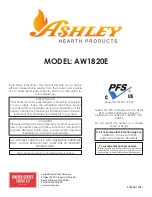
15
4.3. Combustion control. The appliance has mechanisms to regulate combustion.
4.3.1. Primary register. The primary register is used to control the air entering the combustion chamber through the
base of the fire, through the fire grate. The primary register should be used mainly for lighting and, if necessary, to aid
combustion. To locate the register control handle and to know how to use it see picture "D.2" on page 9 of the ANNEXED
document. If fuel is low quality you can adjust the path of the primary register following the passos: "D.26" to "D.29". If
the problem persists adjust the air entry by fire grate following the steps “D.26” and “D.30”.
4.3.2. Secondary register. The secondary register is used to control the air entering the combustion chamber from the
top. The secondary register is used as combustion intensity adjustment. To locate the register control handle and to
know how to use it see picture "D.3" on page 9 of the ANNEXED document. If fuel is low quality you can adjust the path
of the secondary register following the passos: "D.26" to "D.29".
4.4 Fire lighting. To light the fire, use suitable materials for this purpose, such as heat pads, paper, dry and thin
branches. DO NOT USE GASOLINE, SOLVENTS OR ALCOHOL. To see the correct position see picture "C.5" on page
9 of the ANNEXED document, then light the fire using a suitable material. Once the fire is lit keep the door and the
registers open for a reasonable time to prevent condensation on the door. When the apparatus is hot enough close the
door, adjust the primary register to avoid excessive combustion and control the intensity of fire by the child record.
4.5 Loading and reloading of fuel. Do not exceed the maximum allowed load or reload. (See Table of Technical
specifications).
4.6 Door opening. The door must be opened only for reloading. To open it, follow the steps described in picture "D.1"
on page 9 of the ANNEXED document.
4.7 Operation in adverse weather conditions. It is possible for the device to malfunction due to sudden or unexpected
weather changes, causing: low pressure, ebb currents of air into the smoke duct. When these phenomena are observed
it is advisable to close the combustion register and turn the equipment off.
4.8 Fire Prevention. You must not place any flammable element outside the safety distance from the fireplace described
in the table in section 1.1 Technical specifications. You shall also take special precautions if there are children and
elderly people present. In case of fire, push away all the people around it, close the registers as much as possible and
notify the Firefighting service.
ALL LOCAL REGULATIONS, INCLUDING THE ONES ACCORDING TO THE NATIONAL OREUROPEAN NORMS
MUST BE ACCOMPLISHED WHEN PROCEEDING TO CONNECT THEA PPARATUS TO ELECTRICAL
INSTALLATIONS
5.1. Components. The appliance is equipped with two fans for models Habit 76 LD/LI, and with four fans Habit 96 LD/LI,
a thermostat and an ignition device, resistance, turbine control switch, inner cables and wires as well as silicon tube for
air outlet. For parts refer to part V of the ANNEXED document.
IMPORTANT: -The interior vermiculite parts SHOULD NOT RECEIVE IMPACTS when refueling is
performed.
If any of these parts crack, but is properly set in its place, THE PROPER OPERATION OF
THE APPLIANCE SHALL NOT BE ALTERED AND THERE IS NO POTENTIAL RISK. The
equipment can be used normally. These cracks do not entail any manufacturing defect so
they do not fall under guarantee.
5. ELECTRICAL INSTALLATION
















































